What Happens if a Baby's Fontanel Closes Too Soon
Primal Points
- Almost experience with minimally invasive correction in the region
- Helmet Programme in our role
- Craniosynostosis patients are supported past an entire craniofacial panel
- Dr. Sun and Dr. Toth have performed over 350 cases together. They have developed surgical techniques that come only with years of experience to accomplish the all-time possible results
What is Craniosynostosis?
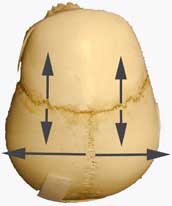
A babe's skull is fabricated up of several big basic. The places where these basic bear on are flexible connections called sutures. The location where four of these large bones meet in the front end of the head is called the anterior fontanelle, or soft spot (in that location is another ane in the dorsum of the head). This flexibility allows the caput to fit through the nascence canal, and permits the brain to grow. The brain quadruples in size the starting time two years of life, and the bones of the skull must grow and not restrict its growth. Bone growth occurs at these sutures
When a suture is non formed or closes too shortly, it is called craniosynostosis. It is estimated that this defect occurs in one out of every 2000 live births.
Craniosynostosis Symptoms
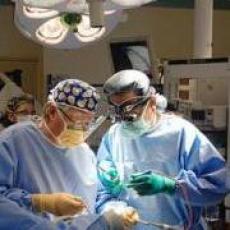
Drs. Lord's day and Toth Operating
Craniosynostosis causes the caput shape to be deformed, and in certain instances, tin can prevent the brain from having enough room to grow. The specific abnormality of the caput shape depends on which suture(due south) is closed. An abnormal head shape is noticed after birth.
The main sutures of the skull are the sagittal, metopic, coronal and lambdoid. Sagittal synostosis is the most common suture to shut too soon, and information technology inhibits growth of the skull on both sides. The skull compensates by growing longer in the front and back, with a very big forehead and narrow pouched out back of the skull. This is called dolicocephaly (or scaphocephaly). In addition to a plain-featured skull, in that location is a real risk that the brain may not have enough room to abound in sagittal synostosis. Elevated cranial pressure level and subsequent neurological damage can occur.
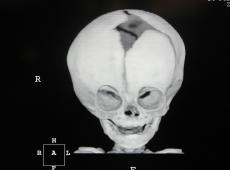
Unilateral Coronal Suture Synostosis
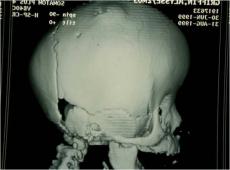
Brachycephaly
Coronal suture synostosis can involve one or both coronal sutures. Still, it is much more common for but one coronal suture to exist involved. This causes flatness on the forehead of the affected side, as well as noticing that the eye socket is pulled up on that side. When both coronal sutures are fused as well soon, the skull cannot grow front to back. The skull instead grows side-to-side, which is called brachycephaly.
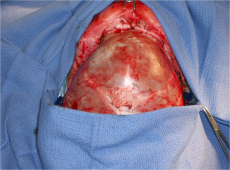
Metopic Surgery
When the metopic suture closes besides shortly, it may or may not be a problem. Information technology is not a trouble when the only noticeable feature is a ridge on the brow. It is a trouble when the forehead becomes keel shaped (but like the front of a boat). This is called trigonocephaly. Additionally, the eye sockets may not grow laterally, giving the appearance that the eyes are besides close together. As well, the temporal area on each side of the skull (near the temples) cannot grow laterally, creating a hallow appearance in the child'southward temples.
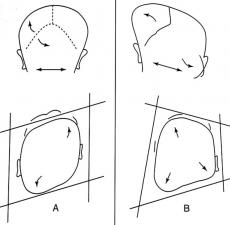
A. Right plagiocephaly
B. Right Lambdoid craniosynostosis
The last and to the lowest degree common suture to shut too soon is the lambdoid suture. It causes flatness in the dorsum of the head on the affected side. It can look similar positional plagiocephaly, a benign flatness of the back of the head acquired by babies spending too much time on the back of the caput. On rare occasions, all the sutures in the skull are fused. This is a dangerous situation where force per unit area tin build up in the brain and urgent handling is needed in the few months subsequently birth.
Craniosynostosis Treatment
Treatment for craniosynostosis is required to preclude the psychosocial implications of having a major deformity and in many cases to prevent elevated brain pressure. Usually, the surgery is done by both a neurosurgeon and a plastic surgeon. Sometimes a craniofacial team coordinates the care of the child.
At that place are ii broad categories of surgery for craniosynostosis. Regardless of category, it is important to emphasize that while this is skull surgery and not brain surgery, the procedures are still considered major operations.
Minimally Invasive Surgery
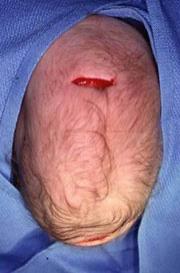
View of the smaller incisions
The commencement category is chosen "minimally invasive" or endoscopic surgery. It is requires an early on diagnosis every bit information technology is but done during the beginning few months of life. This procedure involves removing the fused suture and strips of bone with an endoscope or lighted retractor through two small incisions.
This less invasive surgery is followed by several months in a peculiarly designed helmet to help mold the kid's skull into normal shape. We are the only squad in Northern California with extensive experience with this surgery and our results have been excellent.
Read our coverage in the Contra Costa Times for more data, or sentinel Samuel's Craniosynostosis Story.
Invasive Surgical Process

Incision from the top of the ear
to the peak of the ear
The more invasive, or traditional repair, is typically done when the kid is 6-12 months in age. In this involved surgery we rearrange the bones in the skull to achieve a normal skull shape and size. The fourth dimension in the operating room and the time in the infirmary are typically longer.
In a traditional repair for older children, major portions of the skull are removed to mechanically reconstruct the skull and the incision is from the top of i ear to the summit of the other. The incisions are all made behind the patient's hairline.
The long-term outcomes for virtually patients with craniosynostosis are first-class. Surgery is generally recommended to reduce the hazard of increased encephalon pressure from the skull not having plenty room for the brain. This increased brain force per unit area can cause brain damage. Also, surgery is by and large recommended to help these children accept a normal head shape for cocky-esteem and social issues. Without surgery the deformity of the head will continue to worsen as long equally the caput keeps growing in size.
Source: https://pediatricneurosurgery.org/diagnosis/craniosynostosis
0 Response to "What Happens if a Baby's Fontanel Closes Too Soon"
Post a Comment